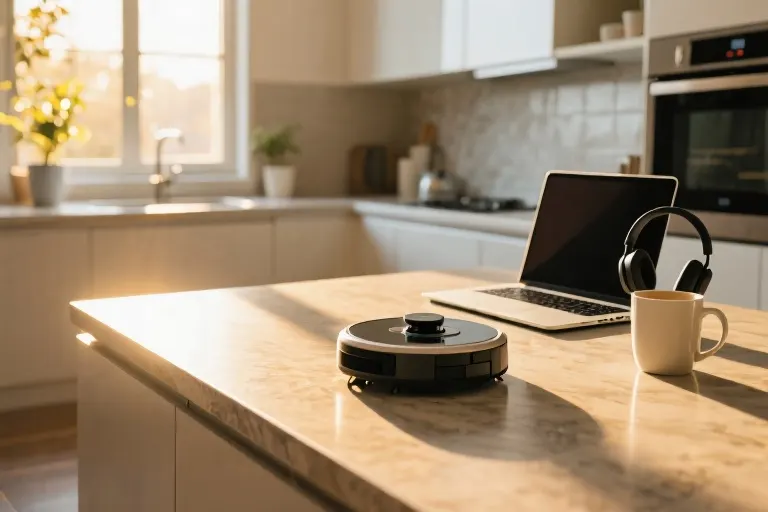Three years ago, I uninstalled every writing app on my computer with the righteous fury of a purist. A blank page, a strong cup of coffee, and the clatter of my mechanical keyboard—that was all I needed for real writing. Or so I thought. Apps were distractions. Fancy tools felt like cheating. If Hemingway could write on napkins, why did I need anything more than a text editor?
Then came the deadline that changed everything. A 5,000-word feature article due in 48 hours. My fingers ached from typing, my thoughts kept outpacing my typing speed, and the blinking cursor mocked my growing panic. In desperation, I googled “speech to text for writers” and stumbled upon Speechnotes—a free, browser-based tool I’d never heard of in any writing circle.
What happened next felt like discovering electricity after years of rubbing sticks together. I spoke my first sentence aloud: “The problem with traditional writing tools is they make you think with your fingers instead of your brain.” The words appeared instantly on screen, perfectly punctuated. For two hours, I paced my kitchen, dictating paragraphs while stirring soup, the ideas flowing faster than I could have typed them. That article got submitted with time to spare—and became my first viral piece.
This wasn’t just about speed. Something fundamental shifted in how I approached writing. The mental friction between thought and text disappeared. Awkward transitions smoothed out because I was literally speaking them aloud. Complex ideas emerged fully formed instead of being fractured by backspacing. Most surprisingly, my drafts retained a conversational rhythm that readers later praised as “effortlessly engaging.”
All from a tool that required no downloads, no subscriptions, no learning curve. Just a browser tab and the courage to talk to myself. What began as a desperation experiment became my secret weapon—the kind of simple, brilliant solution that makes you wonder why everyone isn’t using it. The answer, I suspect, is the same stubborn myth I once believed: that real writing must hurt a little, that tools dilute the craft. But here’s the truth I wish I’d known earlier: great writing isn’t about how you get words on the page—it’s about getting out of your own way so the words can come alive.
From Resistance to Reliance: My Writing Tools Evolution
There was a time when I believed writing required only two things: the stark whiteness of a blank page and the bitter sting of strong coffee. Tools? Apps? Distractions, all of them. Writing should be raw, painful even—a direct channel from brain to fingertips without technological mediation. I took pride in my slow, deliberate keystrokes, convinced this was how real writers worked.
This romanticized notion began crumbling during a particularly brutal deadline. My fingers couldn’t keep pace with my thoughts, creating a frustrating bottleneck where good ideas evaporated before reaching the page. The more I tried to type quickly, the more my prose became stilted and unnatural. That’s when I accidentally left my microphone on during a video call, watching in real-time as speech recognition software transcribed my ramblings with surprising accuracy.
Curiosity led me to Speechnotes, a browser-based voice-to-text tool that felt different from clunky dictation software I’d tried before. No downloads, no subscriptions, no feature overload—just a clean interface where spoken words instantly became written ones. At first, using it felt like cheating, as if I’d discovered a secret elevator in the marathon of writing.
The breakthrough came when reviewing my first voice-drafted piece. Unlike my usual stiff, over-edited prose, these sentences retained the natural rhythm of conversation. Transitions flowed better. Complex ideas emerged more clearly. Most surprisingly, my writing speed nearly tripled without sacrificing quality. What began as a desperate experiment became a permanent shift in my creative process.
This transition wasn’t immediate. Old habits die hard, and I initially kept returning to my keyboard like a security blanket. But gradually, I noticed something revealing—when stuck on a difficult passage, speaking it aloud often unlocked the solution. The physical act of vocalizing seemed to access different cognitive pathways than typing, making abstract concepts more tangible.
Now, my writing routine has fundamentally changed. Morning pages become morning monologues. Plot holes get worked out during dog walks. Character dialogues test their authenticity by literally being spoken aloud. The tool didn’t just make me faster; it made me more attuned to the musicality of language itself.
What fascinates me most is how this simple technology exposed my unexamined biases about writing. That visceral resistance to tools wasn’t about preserving artistic purity—it was fear. Fear that easier might mean worse. Fear that removing friction would somehow dilute the work. Yet the opposite proved true. By eliminating the mechanical barrier between thought and expression, the writing became more authentically mine.
Why Speechnotes Stands Out: Three Game-Changing Advantages
The first time I opened Speechnotes, I expected another clunky voice-to-text app that would make me regret abandoning my keyboard within minutes. What I found instead was something quietly revolutionary—a tool so thoughtfully designed that it disappeared into the background of my writing process. Here’s what makes it different.
No barriers, just writing
Most voice transcription services feel like navigating an obstacle course. Download this app, create an account, accept cookies, watch an ad—by the time you start dictating, your train of thought has left the station. Speechnotes cuts through the nonsense. Open Chrome or Safari, type ‘speechnotes.co’, and you’re already speaking words onto a blank page. No registration walls, no ‘free trial’ traps, no upsells hiding in the settings menu. It’s the digital equivalent of picking up a pen—immediate and frictionless.
Design that gets out of the way
Compare two screens: On the left, a popular voice app cluttered with toolbars, formatting options, and a dashboard showing your ‘productivity score’. On the right, Speechnotes—a pale yellow notepad with a microphone button. That’s the entire interface. No autosave notifications interrupting your flow, no pop-ups suggesting premium features. The genius lies in what’s missing: every pixel serves the single purpose of capturing spoken words without editorial interference. For writers who’ve wasted hours wrestling with complex software, this simplicity feels like oxygen.
Accuracy that keeps up with your mind
Where other tools stumble over contractions or proper nouns, Speechnotes handles conversational speech with surprising grace. It nails tricky phrases like ‘self-deprecating humor’ and adapts to mixed-language dictation (try switching between English and Spanish mid-sentence). The secret? Unlike apps built for generic transcription, its algorithms seem optimized for the rhythms of creative writing—pausing at commas, catching em-dashes, even recognizing when you’re verbally striking through a sentence (‘scratch that…’). While no service achieves perfection, this one comes close enough that editing feels like polishing rather than deciphering.
What surprised me most wasn’t any single feature, but how these elements worked together. The lack of sign-ups meant I could test it during fleeting moments of inspiration. The minimalist interface kept me focused during marathon writing sessions. The reliable accuracy let me trust the tool enough to think through ideas aloud. Most writing tools promise to help you work better—this one actually disappears so you can.
The Efficiency Revolution: Voice vs. Keyboard
For years, I measured writing progress by the rhythmic tapping of keys – each clack supposedly proof of productivity. Then came the morning I decided to test something radical: speaking instead of typing. What began as a desperate experiment during a tight deadline became a permanent shift in how I create.
The numbers don’t lie. When timing identical 1,000-word drafts:
- Keyboard: 47 minutes (21 words/minute) with 3 intentional pauses to rest fingers
- Voice: 12 minutes (83 words/minute) including natural speech hesitations
That 72% time savings only tells part of the story. The real magic happens in how speech alters creative flow. Cognitive research shows verbal expression activates Broca’s area differently than manual writing, creating more fluid connections between ideas. My own drafts transformed from stiff, over-edited prose to conversational narratives that retained their original energy.
Three unexpected benefits emerged:
- The Stamina Factor
Voice eliminates the physical fatigue of marathon typing sessions. Where my hands previously demanded breaks every 90 minutes, I can now sustain creative output for hours through speech. - Error Advantage
Counterintuitively, voice transcription’s occasional mistakes (about 8% in my case) often spark better phrasing. A misheard “their” becomes “there,” suddenly revealing a poetic double meaning I’d never have typed deliberately. - Memory Preservation
Speaking captures fleeting ideas before self-editing intervenes. The raw audio playback preserves creative context that typed words alone can’t – the pregnant pauses, the excited tempo shifts, the half-formed concepts worth revisiting.
Of course, voice drafting requires adjustment. Initial attempts produced rambling transcripts needing heavy editing. But within two weeks, I developed speech patterns that yielded cleaner first drafts – slightly slower dictation, strategic pauses between thoughts, and mental “punctuation” spoken aloud (“comma,” “new paragraph”).
The productivity gains extend beyond word counts. By separating composition from transcription, I finally experience what writing coaches mean by “thinking on the page.” My ideas now flow at the speed of speech rather than the speed of typing, with all the messy, glorious spontaneity that entails.
For those skeptical about abandoning keyboards, consider a hybrid approach. I still edit manually – the tactile feedback helps refine sentences. But for raw creation? My fingers have become bystanders in a process that now happens at the speed of thought.
Beyond Writing: 5 Unexpected Use Cases for Speechnotes
The beauty of a truly great tool lies in its adaptability. What began as my personal solution for faster drafting gradually revealed itself as something far more versatile. Here’s how this unassuming voice-to-text application transcends traditional writing scenarios.
Academic Research Made Fluid
Grad students drowning in interview transcripts will appreciate this: Speechnotes handles live lecture capture with surprising accuracy. During my thesis work, I recorded professor consultations directly into the browser, watching my questions and their insights materialize as searchable text. No more frantic notetaking that distracts from actual listening. The raw output needs editing, but you preserve every nuance – including those spontaneous ‘aha!’ moments that formal writing often filters out.
Multilingual Writing Without Fear
For non-native English speakers, the mental hurdle of perfect grammar can paralyze creativity. A Japanese colleague shared how speaking her drafts first in Speechnotes, then refining with Grammarly, helped her submit papers without the usual week-long editing agony. The tool doesn’t judge accents – it simply captures your meaning. This psychological safety net matters more than any accuracy percentage.
Accessibility Beyond Compliance
While researching assistive tech, I discovered disability advocates using Speechnotes for entirely different reasons. Those with repetitive strain injuries maintain writing careers by voice. A Parkinson’s patient composes emails during tremor-free moments. The browser-based access means no expensive specialized software – just open and speak when ability allows.
Commuting Productivity Hack
Train rides became my mobile office. Dictating blog outlines or client emails while standing on a subway might look odd, but arriving with 800 words already drafted feels like cheating. The mobile browser version even works offline, syncing when you reconnect. For freelancers juggling multiple gigs, these stolen moments add up.
Creative Brainstorming Unleashed
Here’s the counterintuitive bit: sometimes the ‘mistakes’ spark ideas. When Speechnotes mishears ‘market analysis’ as ‘mermaid paralysis,’ my fiction-writing friend found her next short story premise. The tool’s literal interpretation becomes a kind of AI-assisted word association game. For stuck writers, speaking random thoughts and seeing how they transform in text can break mental blocks.
What these scenarios share isn’t about typing versus speaking – it’s about removing friction between thought and expression. The right tool disappears, leaving only the work. That’s when technology serves creativity best.
The Perfect Workflow: Pairing Speechnotes with Grammarly
There’s an unspoken truth about writing tools – no single application can do everything well. The magic happens when we combine specialized tools to create something greater than the sum of their parts. This realization transformed my writing process from frustrating to fluid.
Speechnotes handles what it does best – capturing raw thoughts at the speed of speech. But spoken words often need polishing. That’s where Grammarly enters the picture, creating a seamless transition from verbal brainstorming to polished prose.
The Natural Division of Labor
The workflow breaks down simply:
- Ideation Phase: Open Speechnotes and speak freely without self-editing
- First Draft: Export the text with basic formatting
- Refinement: Paste into Grammarly for structural and grammatical cleanup
This separation of concerns mirrors how our brains naturally work – first generating ideas, then refining them. Trying to do both simultaneously often creates cognitive friction.
Practical Formatting Tricks
Voice-to-text inevitably introduces quirks that need addressing:
- Filler Words: We say “um” and “like” without noticing. A quick Ctrl+F for these verbal tics cleans up 30% of issues
- Paragraph Breaths: Notice where your speech naturally pauses – these often indicate needed paragraph breaks
- Punctuation Commands: Speechnotes understands “new paragraph” and “comma,” but double-check their placement
Grammarly then handles what speech can’t easily convey – proper article usage, complex punctuation, and subtle grammatical nuances. The combination feels like having an attentive scribe and meticulous editor working in tandem.
Beyond Basic Proofreading
What makes this pairing particularly powerful is how each tool complements the other’s weaknesses:
- Speechnotes keeps Grammarly from making your writing sound overly formal
- Grammarly prevents Speechnotes from leaving your prose too conversational
- Together they strike that elusive balance between natural flow and professional polish
The real beauty lies in how this workflow accommodates different thinking styles. Some days I dictate full paragraphs, other times just bullet points. The tools adapt rather than forcing me into rigid structures.
For those worried about losing the “human touch” – the final pass always remains yours. These tools simply remove the mechanical barriers between thought and expression, letting you focus on what matters – the ideas themselves.
The Right Tools Bring Writing Back to Life
Tools are just tools. They don’t write for you, they don’t think for you, and they certainly can’t feel for you. But the right tool? That’s like finding the perfect pair of shoes after years of blisters – suddenly you remember what walking was supposed to feel like all along.
What Speechnotes gave me wasn’t just speed or convenience. It returned something fundamental that I’d forgotten writing could be: effortless expression. When your fingers can’t keep up with your thoughts, you start editing ideas before they even hit the page. But speaking? That’s how stories were meant to be told – around campfires, across kitchen tables, in the spontaneous back-and-forth of human conversation. This silly little browser tab somehow bridges that ancient instinct with modern technology.
I still keep a notebook by my bed. Some mornings I’ll wake with half-formed sentences tumbling out, grabbing whatever pen’s within reach to capture them before they dissolve. The ink smears, the handwriting’s illegible, and half the pages end up crumpled on the floor. It’s messy and imperfect and absolutely necessary. Because here’s the secret no productivity guru will tell you: tools matter, but only insofar as they disappear. When a hammer feels like an extension of your arm, when a paintbrush becomes part of your hand, when a voice-to-text app stops being technology and starts being thought-to-page – that’s when the real work happens.
Try it. Right now. Open Speechnotes in one tab and start talking to nobody. Describe the room you’re in, rant about your neighbor’s loud music, whisper the opening line of that story you’ve been too afraid to write. See how the words appear without your fingers moving, how your breathing syncs with the rhythm of sentences, how your shoulders drop when you realize nobody’s grading your typos. Then close the tab if you hate it. No accounts, no downloads, no commitment. Just you and your voice and the blank page, same as it’s always been – only now, maybe, a little more alive.






Hey very cool website!! Man .. Excellent .. Amazing .. I will bookmark your blog and take the feeds also…I’m happy to find a lot of useful information here in the post, we need develop more techniques in this regard, thanks for sharing. . . . . .